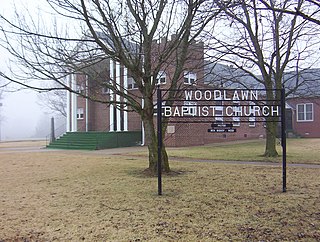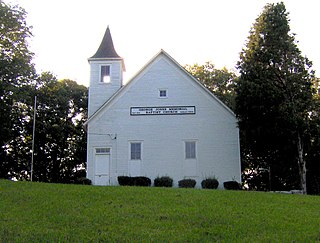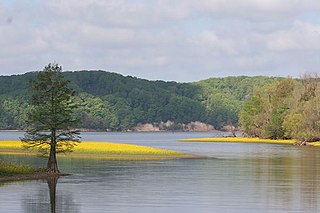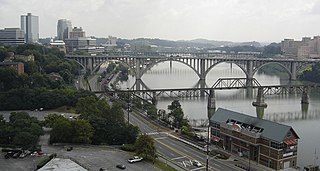
East Zorra-Tavistock is a township in southwestern Ontario, Canada, formed on 1 January 1975 through the amalgamation of the Township of East Zorra and the Village of Tavistock. It is part of Oxford County. The township had a population of 6,836 in the Canada 2011 Census.

Nutbush is a rural unincorporated community in Haywood County, Tennessee, in the western part of the state. It was established in the early 19th century by European-American settlers who brought along or bought enslaved African Americans as workers to develop the area's cotton plantations. The African Americans built houses and churches that still stand.

Woodlawn Baptist Church and Cemetery, also known as Woodlawn Missionary Baptist Church, is a historic building in Nutbush, Haywood County, Tennessee, in the United States. It is on Woodlawn Road, south of Tennessee State Route 19.

Madison Township is one of ten townships in Jefferson County, Indiana, United States. As of the 2010 census, its population was 17,415 and it contained 8,087 housing units.

Monroe Township is one of ten townships in Jefferson County, Indiana, United States. As of the 2010 census, its population was 374 and it contained 176 housing units.

The George Jones Memorial Baptist Church, also known as the "Wheat Church," is a historic church building at the former site of the community of Wheat in Oak Ridge, Tennessee, United States. It is the only structure remaining from Wheat, a rural Roane County community that was dissolved in 1942 when the United States government assumed ownership of the land for the Manhattan Project.

Richard Henry Boyd, commonly known as the Rev. Dr. R. H. Boyd, was an African-American minister and businessman who was the founder and head of the National Baptist Publishing Board and a founder of the National Baptist Convention of America, Inc.
Mt. Zion Presbyterian Church is located in Sandy Springs, South Carolina, USA. It is a part of the PCUSA denomination and is located in the Foothills Presbytery of the Synod of South Atlantic.

Republican Primitive Baptist Church is a historic African-American church of the Primitive Baptist tradition located in rural Haywood County, Tennessee, about 10 miles west of Brownsville.

Mount Zion Missionary Baptist Church is a historic African-American church at 305 W. Maple Street in Fayetteville, Tennessee.

Hackney Chapel AME Zion Church, also known as Unitia AME Zion Church, is a historic African-American church in rural Loudon County, Tennessee. The adjacent cemetery has about 100 marked graves and up to 200 unmarked graves. The church and cemetery were added to the National Register of Historic Places in 2000.

Mt. Zion Christian Methodist Episcopal Church, formerly Mt. Zion Colored Methodist Episcopal Church, is a historic African-American church in Union City, Tennessee, at the corner of North Greenwood and East College Streets.

Mount Zion Missionary Baptist Church is a historic church at 409 S. Main Street in Brinkley, Arkansas. It is a red brick building with front facing gable roof, and a pair of square towers flanking the main structure. The left tower is slightly taller, an intentional element of the design that was maintained when one tower had to be shorted by removal of its belfry. The towers are joined by a three-bay porch sheltering the building's main entrance. The church was built in 1909 for an African-American congregation established in 1886, and has been a major cultural focus for that community since.

Flippin is an unincorporated community located in Monroe County, Kentucky, United States. A small residential village is located on Highway 249, approximately 3.6 miles south of the Monroe-Barren County line. The village and community surround the intersection of Highway 249, Highway 678, and Highway 100. Flippin is situated northwest of Gamaliel, west of Tompkinsville, and east of Fountain Run.

Spanish Camp is an unincorporated community in north central Wharton County, in the U.S. state of Texas. The community is located between Egypt and Hungerford along Farm to Market Road 1161 (FM 1161) near its intersection with Farm to Market Road 640 (FM 640). After the Mexican army of Antonio López de Santa Anna camped at the site in 1836, the community took the name Spanish Camp. In 1870 a church in the community was founded by former slaves and the congregation still existed in 2013.





























